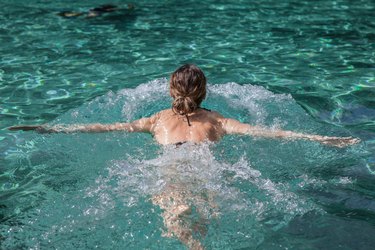
Swimming is a great way to switch up your land-based workouts, train your muscles from head to toe and take it easy on your joints. But if you're trying to boost your heart health or burn calories in the pool, it's natural to wonder how good swimming for cardio really is.
Here's everything you need to know to get the greatest cardio benefits from swimming.
Video of the Day
Video of the Day
Is Swimming Cardio?
Yes! Swimming raises your heart rate, increases your circulation and strengthens your heart.
Like other forms of cardio exercise, swimming can help reduce the risk of heart disease, high blood pressure and stroke. For example, in a May 2017 British Journal of Sports Medicine study that followed people for 20 years, adults who regularly swam had a 41 percent lower risk of heart-related death.
Bonus: Unlike with land-based forms of cardio, when you swim, your body is nearly horizontal in the water. This allows more of your blood to move back to your heart rather than pooling in your legs, according to Harvard Health Publishing.
Swimming for Cardio vs. Running
You might be surprised to learn that, according to Harvard Health Publishing, swimming and running burn roughly the same number of calories per hour.
While running is an excellent cardiovascular activity, it does place a lot of pressure on your joints. Some pressure on your bones and joints helps keep them them strong. But if you have any injuries or a joint condition such as arthritis, you can use swimming as cardio to help avoid joint pain when exercising.
In a small March 2016 Journal of Rheumatology study, people with osteoporosis reduced their joint pain and stiffness by swimming for 45 minutes three days per week.
3 Swim Cardio Workouts for Beginners
The American Heart Association recommends adults do at least 150 minutes per week of moderate exercise, or 75 minutes of higher-intensity exercise. Slowly increase the time and intensity of your swimming to reach those goals.
Tip
Swim in a safe environment and don't swim alone, especially if you're swimming in a lake or in the ocean. Take breaks and don't push yourself to fatigue, especially when swimming in deep water. As with any other type of workout, remember to drink water and stay hydrated.
1. Water Walking or Running
Walking or running in the pool is a good alternative to swimming laps.
It's an especially great water workout when you're just getting started. Harvard Health Publishing recommends that new swimmers start by swimming for just five to 10 minutes. Walking in the pool is less intense, though, and doesn't as easily fatigue your arms.
So if your arms tire from swim cardio, but you want to continue your workout, walking can help you spend more time in the pool.
2. Swimming Intervals
Interval training use a combination of high-intensity activity followed by a low-intensity activity. This combination not only allows you to recover during the low-intensity period, but also boosts overall cardio conditioning.
The goal of any interval workout is to work hard, building your workout to an anaerobic (oxygen depletion) level, then switching to a recovery phase.
The easiest way to do swim interval workouts is by alternating hard and easy laps. Sprint one, then slowly swim (or even walk) back. Repeat as long as it feels good.
3. Swimming Drill Intervals
High-intensity interval training isn't just full-on racing followed by slow swimming. You can incorporate drills into an interval swimming workout.
For example, you could alternate between upper-body and lower-body swimming drills. During your upper-body work, swim with pull paddles like the Speedo Nemesis Contour Paddle ($16.99; Amazon.com). For lower-body work, do kick intervals with your upper body supported on a kickboard like the VIAHART Swimming Kickboard ($9.99; Amazon.com).
Warning
Take swimming lessons before starting a swimming training program if you don't know how to swim or aren't confident in your technique.
Always Warm Up and Cool Down
Just like with a land-based workout, swimming cardio workouts deserve a good warm-up and cooldown.
Start every swim, whether focused on interval or drills, with a warm up. It's key to warm up for a few reasons. You need to get your muscles and joints ready for the workout to come. You need to check your form and make sure your technique is pristine. You also need to ensure that your equipment is working properly -- your goggles are on right, your cap won't shift and your suit fits comfortably to avoid distractions.
Before heading to the hot tub or shower, cool yourself down with four laps of easy freestyle. It's critical to cool down after a swimming workout, especially one as intense as a swim interval workout can be.
Related Reading
- Harvard Health Publishing: "Exercising in Water: Big Heart Benefits and Little Downside"
- Harvard Health Publishing: "Take the Plunge: Try a Water Workout"
- American Heart Association: "American Heart Association Recommendations for Physical Activity in Adults and Kids"
- British Journal of Sports Medicine: "Associations of specific types of sports and exercise with all-cause and cardiovascular-disease mortality: a cohort study of 80 306 British adults"
- Journal of Rheumatology: "Improved Function and Reduced Pain after Swimming and Cycling Training in Patients with Osteoarthritis"